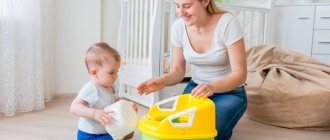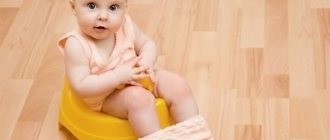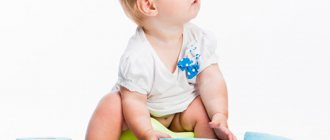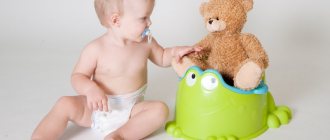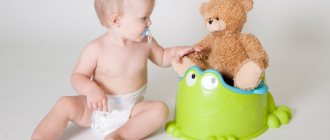Many mothers, as their baby grows, begin to think about the question of what is the optimal age for potty training, and how to do it correctly. There are many opinions regarding this situation. Some people advise doing this right from the cradle, while others recommend waiting.
After all, you should initially evaluate the baby’s development and his psychological preparation. If the child does not understand what this new item is for, then he will not consciously use it. Many experts recommend potty training after 1.5 years. During this period, the mental and physiological development of the child will allow this to be done without difficulty. Many mothers ask how to potty train at 2 years old. The article will discuss the features of this process, its subtleties and methods.
When to introduce your child to the potty
It is believed that the most optimal age for introducing a child to a potty is the period from 18 to 24 months. Most pediatricians agree with this opinion.
When mothers ask how to potty train a 2-year-old child, experts explain some of the features of this process. Due to the fact that children are individual, some are ready to get to know him at 1.5 years old, while others can stretch this process out to 3 years. Boys sit on the potty later than girls. Restless and excitable children may start learning this subject several months later than their calm peers.
So why is it most acceptable to potty train at 2 years old? Usually, until one year old, almost all babies do not feel the activity of the bladder or intestines. Filled organs are released on their own without any awareness. And even when some mothers catch the child and he manages to go to the potty, this does not mean that he does it consciously and the nervous system completely controls the process. This helps save diapers. But most often it is wasted effort and nerves, and sometimes the development of a negative attitude towards the child’s potty.
By 18 months, the baby begins to gradually feel his urges and restrain them. But before complete control, a certain time must pass, when the child acquires some skills that allow him to get used to the potty:
- The child can bend, squat and stand up quickly.
- Collects small objects and can put them in one place.
- Understands adult words and spoken language.
- Can communicate his desires in the simplest words or interjections.
- During daytime sleep, he remains dry and may not pee for 2-3 hours.
- Feels discomfort when wearing wet underwear.
Mothers should understand how to potty train at 2.5 years old, and that they should not follow the example of the neighbor's child. You need to monitor the behavior and development of your baby. And when the moment is favorable, plant it on a pot. Therefore, the process of potty training is individual.
Many mothers wonder how to potty train a 2-year-old boy. At the beginning the process is the same. Only by the age of 3-4 years, according to experts, boys should learn to write while standing.
Five Steps to Potty Training
The main role of parents in instilling cleanliness in their children is to make the process as natural and positive as possible. A little time will pass, and the baby will successfully master everything that you (so far, perhaps unsuccessfully) are trying to teach him. Try to strengthen your child's neatness skills using simple tips.
Before moving on to a step-by-step description of the process, we advise you to read the advice of a psychologist on how to potty train children:
- Buy a potty and place it in the children's room (or toilet). Tell your child what this item is for and how to use it. At first, you can let him sit on the potty dressed, so that the baby does not feel afraid of him.
- If the child begins to sit on the potty willingly and with interest, invite him to try sitting on it after removing the diaper. Show the correct position - the legs should be firmly on the floor, this is important during bowel movements. Let sitting on a hygiene item gradually become part of your baby’s day, start with 1 lesson and increase to 3-4 times a day.
- When your baby gets used to the presence of a new object in the house, try changing his filled diaper near the potty. Shake the contents of the diaper into the potty so that the child understands that the potty is intended for this purpose.
- Soon after regular practice, encourage your child to use the potty as intended. Remove the baby's diaper and place the potty near the play area. Let your child play near the potty, reminding him that if he wants to “go to the toilet,” he needs to use the object nearby. The child will probably forget about the potty at first, but don’t reproach him for this - just keep reminding him. Wait for the moment when the baby succeeds, and be sure to praise your child.
- Once potty use becomes regular, replace Velcro diapers with disposable training panties. At this stage of potty training, boys learn to urinate in an “adult” toilet, imitating their father or older brother. Girls may also want to use a special toilet seat. Praise your child when he takes the initiative to go to the toilet on his own.
On a note! Learning will go smoothly and without stress if parents maintain a calm attitude in case of mistakes and do not put pressure on their baby.
And in addition, a few more tips on how to easily potty train a child from an experienced mother:
Which potty should parents choose?
Any mother wants the most beautiful and special things for her baby. This may also apply to the potty.
Stores offer a huge selection of different items. They can differ not only in color, but also in shape, material, etc.
Many pediatricians do not advise buying expensive potties that have various bells and whistles. It is advisable for parents to opt for a classic and comfortable copy. A child who is being introduced to a new object may be afraid of a bright color or a loud sound. And in other situations, the baby perceives the potty as a toy and treats it accordingly.
Therefore, the correct copy should be ordinary, without frills. The necessary characteristics of the pot include:
- Sustainability. Kids are very active, so to avoid falling, choose pots with a wide base or footrests.
- Material. It is best if the pot is made of plastic and has a quality certificate. Its surface should not have roughness, seams or other defects.
- Form. It depends on the gender of the child. Girls buy a round shape, and boys buy an oval shape with a protrusion in front.
Before potty training a 2-year-old child, parents need to choose a suitable and convenient one.
What kind of pot should I take?
Today there are a variety of pot models available in stores, so choosing the best one can be difficult. You can also buy a regular classic pot. For a girl, you can buy a regular round pot with a smooth edge; for a boy, an elongated model with a raised edge is better suited. This will eliminate the possibility of leakage.
Two-year-olds really like potty toys made in the shape of a car or a funny fairy-tale character. However, this plus of the model can also turn into a minus if the child perceives the potty as an element of the game and refuses to use it for its intended purpose.
A potty in the form of a stool is very comfortable, as it has a back and allows you to “sit” on it in a comfortable position. It is better to take a plastic model, it is more hygienic.
Basic methods and recommendations
The invention of diapers helped many mothers save a lot of time and effort. But now the time comes when they must be patient. Potty training a child at 2 years old is not the fastest or easiest process. Experienced mothers advise:
- You should not insist and force your child to sit on the potty on the first day. This might scare him. First, you need to gently explain to the baby what it is and place a soft toy on the potty. In this case, the baby's diapers will need to be removed. When there are older children in the house, the baby will be able to copy their behavior and not be afraid to sit on the potty.
- At this time, the child is trying to get acquainted with his body. Therefore, the mother will be able to unobtrusively explain why the external excretory organs are needed so that the baby understands what the potty is for. Many children at this age do not like to be in wet pants, so making friends with the potty will help avoid this.
- After each positive development of this subject, it is necessary to praise the baby. This reinforces the new skill. If attempts are unsuccessful, you should not scold the child so that he refuses to use the potty. It is necessary to gently and calmly explain why it is needed.
- Mothers will have to constantly put the child on the potty after sleep, after eating, and after some time during periods of wakefulness. This must be done until the urge arises. Under no circumstances should you force a child to sit on the potty, so as not to cause rejection.
- While the skill of using a potty is being developed, it should be constantly within the baby’s field of vision. This will allow you to quickly use it if necessary.
Many mothers ask how to teach a small child to go potty. If the baby refuses it, then you should use certain tricks to make the process more fun. You can read a book to your child or play with toys at this time. This will help the baby relax and completely forget about his fears. However, you should also not get carried away with this process, so as not to replace the natural process with a game.
What not to do
To teach a child to go potty at 2 years old, a mother needs to show a lot of patience and effort. There is no need to forcefully hold or sit the baby on this object. This can lead to the opposite effect, and as a protest the child will begin to pee in his pants and other places. In this situation, you need to forget about the potty for a while. After 2-3 weeks you can try again.
How to potty train at 2 years old? You should not leave your baby in wet pants or leggings so that he feels how unpleasant it is. This can lead to negative problems in the form of a psychological block.
You should not force your child to clean up after themselves if they spill something. If he does this on purpose, then you can offer to wipe up after himself. But it is absolutely not recommended to force it.
Mothers should not compare their baby with other children and should not worry that he cannot be potty trained right away. Each child is individual, so everything will definitely work out. If parents treat this topic more easily, it will be easier for both mothers and children.
Common mistakes parents make
Each successful use of the potty should be praised, but not made into a real celebration. Appreciate the baby's independence and remind him that using the potty is much more pleasant than walking around in wet pants and wiping the floor.
On the other hand, you shouldn’t go too hard on your training. Do not force your child to sit on the potty for hours, and do not sit him down every 10 minutes, this will only cause hostility in the baby. There is no need to constantly impose thoughts on the baby about the need to master toilet skills. The child will start asking to go to the toilet on his own if you structure your training correctly.
Forbid all family members, especially grandmothers, from scolding and shaming the child for “punctures.” A two-year-old himself can understand that he did something wrong; an additional negative reaction from close adults will only aggravate the feeling of guilt and slow down the learning process. Excessive negative statements can result in psychological problems in the future.
Any serious stress can interfere with learning, so you should not train your child if he or someone in the family is not feeling well or has recently suffered from an illness. A change of environment also interferes with potty training, so do not start training if you are planning to move or have recently changed your place of residence. Your baby needs to feel safe in a new place before he can develop new skills. The loss of a close relative or the divorce of parents is a serious psychological trauma for a baby; allow him to recover from it before developing toilet skills.
Every baby learns the potty sooner or later, so you just need to be patient and try different methods until you find the best training option. If you start teaching toilet skills at the age of two, most likely within a year your child will be using the potty without a single mistake.
How to train in 7 days
Many mothers are interested in how to quickly teach a child to go potty. After all, this will help to give up diapers and reduce a woman’s workload with household chores.
There are several methods, one of which allows you to do this in 7 days. This special system was invented by the British Gina Ford and was called the “happy baby”. It is intended for children aged 1.5 years and older who are able to understand simple instructions, try to dress and undress independently, and know the parts of the body.
The technique is designed for 7 days and is as follows:
- The first day begins with removing the baby's diaper and sitting on the potty frequently. You can introduce your baby to an adult toilet and show its functions. The process of sitting on the potty must be repeated every 15 minutes if the process does not work out. The main thing is to keep the child on the potty for 10 minutes, this time will be enough to complete all tasks. If the panties are still dirty, you should not scold the child for it.
- The second day is needed to consolidate skills. At the same time, the mother makes sure that the child does not play too much and replaces the potty in time.
- On the third day, the chosen tactics are continued. The child is also taken for a walk without diapers, so that there is no desire to urinate in them. Before going outside, the baby must be placed on a potty. At first, you can take the potty for a walk to consolidate your skills. Within a few days, the child will learn to endure, and the need for it will disappear by itself.
Many mothers ask how to potty train a 2 year old child. If you follow Gina Ford's method, then by day 4 you can achieve some progress. Children can go to the potty, but they need to be reminded about it periodically. Mothers should remember to constantly praise for positive results and not scold for mistakes. Later, the pot can be placed in the bathroom or in a specially designated room.
How to potty train a child at 2 years old?
The most optimal age for acquiring the corresponding skill is the age of 2 years. But before you start instilling hygiene skills in your baby, you need to make sure that he is ready for such activities.
Choosing a pot
The potty should be safe and comfortable for the child. When choosing it, you should consider the following:
- Material (polystyrene or polypropylene).
- Model (classic round - for girls, anatomically shaped potty-saddle - for boys).
- Size (must match the child's height).
- Useful elements (the presence of a lid, a handle for easy emptying, a rubber “skirt” at the bottom to prevent tipping).
Modern models can also be seen on sale. A potty chair is comfortable, but its size must exactly match the baby’s height. The musical potty makes sounds when the child has “done his business” (which is very convenient for mothers and interesting for the child). But models in the shape of animals and cars can cause harm. Often children mistake such models for toys; they “ride” with pleasure on them, but do not “do their business.”
Introducing a child to the potty
Even before the start of classes, the mother must explain to the baby what a potty is and what it is needed for. This way the child will understand that the device is not a toy, but an object that will help him stay clean and dry.
Potty training
The following techniques will help to teach a child at 2 years old to go potty:
- Using toys as an example, show how to go to the toilet. You need to take a rubber toy with a hole. Fill the toy with water. “Place” the baby doll or teddy bear on the potty, press on the toy, releasing the water. The baby will see that the toy is peeing in the potty.
- A child of 2 years old should be potty trained gradually. First, the child is dropped off after waking up, before and after meals, before bedtime, then before and after walks.
- Stop using diapers.
- As soon as the baby has done his “wet chores,” you need to praise him and say approving words.
- Training should take place in a playful way. The mother should not be nervous and yell at the child if he does not want to pee or poop.
- The final stage of training is when the baby begins to go to the potty on his own.
Potty training a boy
At the age of 2 years, in boys, the process of emptying the intestines and bladder occurs simultaneously. Therefore, the child should be taught to sit on the potty, and not be forced to pee while standing. If the baby has already pooped, then you can move on to the “male” version.
Potty training a girl
Girls try to imitate their mother, so it is easier for them to understand the principle of the corresponding process. Potty training for girls is carried out using standard methods.
Small tricks
If a child has misfires, you can use small tricks:
- show by your own example how to correctly use an unfamiliar device;
- do not keep the baby on the potty for more than 5-7 minutes;
- wear light clothing without ties, laces or buttons on the pants;
- place the potty in a place accessible to the baby;
- buy a new model together with your child, focusing on his wishes;
- if a child is afraid of the potty, then get him interested in looking at pictures in books, watching cartoons, etc.
Quick training in 3 days
Many mothers ask how to potty train quickly at 2 years old. Usually in this situation there is no rush, so as not to cause disgust for the process itself. And the formation of a conscious skill can take more than one month.
However, a situation arises when it is necessary to speed up the potty training process. This does not mean that the baby will learn to do this perfectly once and for all. But quick training will help you realize the need to go to the toilet.
For this technique to work, the child’s readiness for this process is determined. Here are some factors that make potty training worthwhile:
- The child is 2 years old, or at most 2 years 1 month.
- The baby can stand it freely for 1-2 hours without getting his panties wet.
- The child does not want to put on diapers.
- He has developed a process of defecation that occurs at the same time.
If all of the above signs are met, then 2 weeks before the training process you must:
- Buy a potty and explain its purpose to your child.
- The baby needs to be told that small children sit on the potty and then on the toilet, and other people do this.
- 5-6 days before the scheduled event, it is explained that the child will soon wear panties and go to the toilet.
- It is specially necessary to choose a few days when you can deal only with the baby.
When the time comes, they move on to the potty training process:
- First day. The child must go without diapers at all times. You can wear panties. The mother needs to monitor the child all day and literally follow him with the potty. As soon as the mother notices that the baby wants to go to the toilet, he is immediately seated on it. And this must be done every time. If a child goes to the potty, then he needs to be praised in every possible way. Mistakes should be ignored so as not to create negativity.
- Second day. The mother also needs to monitor the child and sit her on the potty. You can go for a walk, but only without diapers. Before going outside, the child is seated on the potty and the time is planned in such a way as to quickly return home. It would be a good idea to have spare clothes.
- The third day. You are allowed to go for a walk twice. The baby is already pottying at home. But it is necessary to teach him to restrain himself when he is absent.
Potty training at 2 years old is a difficult process, even if it takes 3 days. This will help him adapt and even make his first independent attempts. The baby needs to choose comfortable clothes so that he learns to take them off on his own.
How to teach to get up at night
Introducing the potty makes it much easier to wean your baby out of diapers and encourages bladder awareness. In the period from 1.5 to 3 years, the child begins to feel the urge, first during the day and then at night.
How to teach a child to go potty at night? This can be done using the following methods:
- You can organize a special regime. Usually the mother knows when the child wants to pee and should be guided by this time. It could be 12 at night, 4 in the morning. This leads to some difficulties, but there are also positive aspects. Mom can predict when the child wants to pee, and he will not wet himself at night.
- If a child does not get up at night, you can teach him to call his mother. Having gotten used to waking up his parents, the child will learn to sit on the potty.
- Some parents limit the amount of liquid their baby drinks at night. There is a certain positive here, but you should not completely remove water from your baby’s diet.
Many mothers ask how to teach their child to go potty at night. Sometimes all methods and methods of introducing a baby to the night toilet turn out to be unsuccessful. Moms should still try to potty train their child and give up diapers completely. She should not be nervous and yell at the baby. Up to 4 years of age this is not a problem, but after this age it is a reason to visit a doctor.
Marina Romanenko - potty training
Video consultation: 9 tips for parents from a psychologist, creator of the First Children's Academy and School of Professional Parents, business coach and mother of four children (two with her husband), Marina Romanenko on how to quickly potty train a child and what mistakes are most often made parents:
“The Easy Potty Training Formula”
Does this sound familiar? – Your child screams, arches his back and categorically refuses to sit on the potty... You are tired of constantly wiping up puddles on the floor! You don’t know how to help your child get used to “toilet routine”? Are you tired of spending a ton of money on tons of diapers!!Let's see how to potty train a child
Retraining
In some situations, cases arise when the baby categorically refuses to use the potty, although the necessary skill has already been developed. This can happen at two or four years. The reasons may be the following:
- Conflicts that arise within the family have a negative effect on the child. As a result, the baby may withdraw into himself or rebel. Reluctance to use the potty is also one of the negative reactions to what is happening.
- Changing your usual lifestyle. Moving or the birth of a brother or sister comes as a surprise to the child and leads to the abandonment of usual things.
- The 3-year-old crisis can also cause potty refusal. At this time, the child begins to recognize himself as an individual and wants to act in his own way, and not as others demand.
- Potty refusal can occur during illness or teething. When all the forces of a small organism are aimed at recovery, you should not insist on visiting the potty. We need to wait a little.
When mothers are wondering how to potty train at 2 years old, they should take into account negative situations and the child’s health status before moving on to this process.
Time to introduce your baby to the potty
Little children grow up every day, learn new things, develop, and get to know our world. Every new day, month after month, brings the moment closer when you need to introduce the baby to the potty. The introduction should go well so that the child can quickly and painlessly start going to the toilet in a new way.
Our mothers, back in the not-distant 90s, taught their children to potty at a tiny age (7-12 months). I think the main reason was the lack of diapers.
Nowadays, there is no such problem, so most mothers are not concerned about putting their child on the potty early. First of all, the child must be morally disposed to this process and have at least a little understanding, and not just a reflex.
Psychologists recommend starting to put your baby on the potty at the age of one and a half to two years. This age is optimal for development at the physical and psychological level.
Opinion of a famous pediatrician
How to teach a child to go potty? Komarovsky is confident that stable urination skills appear in a child no earlier than 18 months. Therefore, parents are not recommended to engage in this process until they are 1.5 years old. And stable skills appear by 20-33 months. The easiest way to potty train is for children who see their brothers or sisters doing it.
Therefore, parents should see the child’s readiness for the potty, and then buy it. And only then begin to develop the necessary skills.
When to start potty training your child
Leading pediatricians assure that the fact that a child does not ask to use the potty until the age of two is a physiological norm. This is explained by the fact that a person cannot control the processes of urination and defecation independently until this age. However, perseverance and perseverance accelerate the development of such skills, which explains the success of previous generations. That is, if a child wears a diaper until he is two years old, then this is not a reason to grab your head and get upset, wondering when and how to potty train your child. There is a time for everything, as nature intended.

